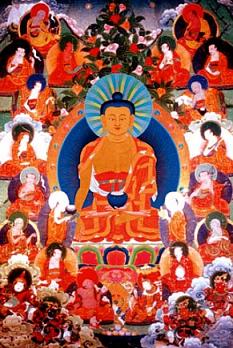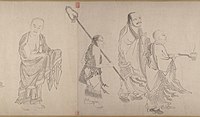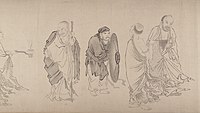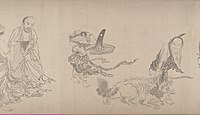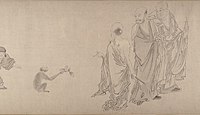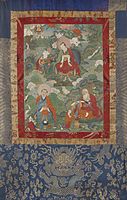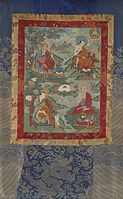Sixteen arhats
The sixteen arhats (C. shiliu luohan 十六羅漢), or sixteen elders (Skt. ṣoḍaśasthavirā; T. gnas brtan bcu drug གནས་བརྟན་བཅུ་དྲུག; C. shiliu zunzhe 十六尊者) are a group of sixteen arhat disciples whom Gautama Buddha asked to remain in this world to protect the his teachings until the arrival of Maitreya (the future buddha).[1] When Maitreya arrives, the group of arhats will gather together and build one last stupa for Gautama Buddha before passing into parinirvana.[1]
This group of arhats is identified in the texts of the Sanskrit tradition and they are recognized in the East Asian and Tibetan traditions.
This group is first recorded in texts of the Tang Dynasty in China, and they came to be revered and China and appear frequently in East Asian Art.[1] In Japan, the sixteen arhats are particularly popular in Zen Buddhism, where they are treated as examples of good behaviour.[2]
In Tibet, the sixteen Arhats, also known as sixteen Elders (sthaviras), are the subject of a liturgical practice associated with the festival of the Buddha's birth.[3] They are also well represented in Tibetan art.[4]
In China, some later texts identified an expanded group of eighteen arhats.
Names of the sixteen arhats
The sixteen Arhats that are identified in the East Asian tradition are listed below. (The Tibetan tradition has a slightly different list.[5])
| Sanskrit | Chinese | Rōmaji | Tibetan |
|---|---|---|---|
| Piṇḍola Bhāradvāja | 賓度羅跋囉惰闍尊者 | Bindorabaradaja sonja | བྷ་ར་དྭ་ཛ་སོ་ཉོམ་ལེན |
| Kanakavatsa | 迦諾迦伐蹉尊者 | Kanakabassa sonja | གསེར་གྱི་བེའུ |
| Kanaka Bhāradvāja/Kanaka | 迦諾迦跋釐堕闍尊者 | Kanakabarudaja sonja | བྷ་ར་དྭ་ཛ་་གསེར་ཅན |
| Subinda/Abhedya | 蘇頻陀尊者 | Sobinda sonja | མི་ཕྱེད་པ |
| Nakula/Bakula | 諾距羅尊者 | Nakora sonja | བ་ཀུ་ལ |
| Śrībhadra/Bhadra | 跋陀羅尊者 | Badara sonja | བཟང་པོ |
| Mahākālika/Kālika | 迦哩迦尊者 | Kalika sonja | དུས་ལྡན |
| Vajriputra | 伐闍羅弗多羅尊者 | Bajarafutara sonja/Bajarahottara sonja | རྡོ་རྗེ་མོའི་བུ |
| Gopaka/Jīvaka | 戎博迦尊者 | Jubaka sonja | སྦྱེ་བྱེད་པ |
| Panthaka | 半託迦尊者 | Hantaka sonja | ལམ་བསྟན |
| Rāhula | 囉怙羅尊者 | Ragora sonja | སྒྲ་གཅན་འཛིན |
| Nāgasena | 那伽犀那尊者 | Nagasaina sonja | ཀླུ་སྡེ |
| Aṅgaja | 因掲陀尊者 | Ingada sonja | ཡན་ལག་འབྱུང |
| Vanavāsin | 伐那婆斯尊者 | Banabashi sonja | ནགས་ན་གནས |
| Ajita | 阿氏多尊者 | Ajita sonja | མ་ཕམ་པ |
| Cūḍapanthaka/Kṣudrapanthaka | 注荼半吒迦尊者 | Chudahantaka sonja | ལམ་ཕྲན་བསྟན |
Galleries
- Ming dynasty painting scroll of the Sixteen Arhats by Qiu Ying. China. Currently held in the Metropolitan Museum of Art
- The Sixteen Arhats from the Alice S. Kandell Collection
See also
Notes
- ↑ 1.0 1.1 1.2 Buswell & Lopez 2014, s.v. ṣoḍaśasthavirā.
- ↑ Manual of Zen Buddhism Daisetz Teitaro Suzuki p.168
- ↑ Translation of the prayer to the sixteen arhats (Lotsawa House)
- ↑ The sixteen arhats in Tibetan art (himalayanart.org)
- ↑ See
 Sixteen Arhats, Rigpa Shedra Wiki
Sixteen Arhats, Rigpa Shedra Wiki
External links
 གནས་བརྟན་བཅུ་དྲུག་, Christian-Steinert Dictionary
གནས་བརྟན་བཅུ་དྲུག་, Christian-Steinert Dictionary
| This article includes content from Sixteen Arhats on Wikipedia (view authors). License under CC BY-SA 3.0. |
